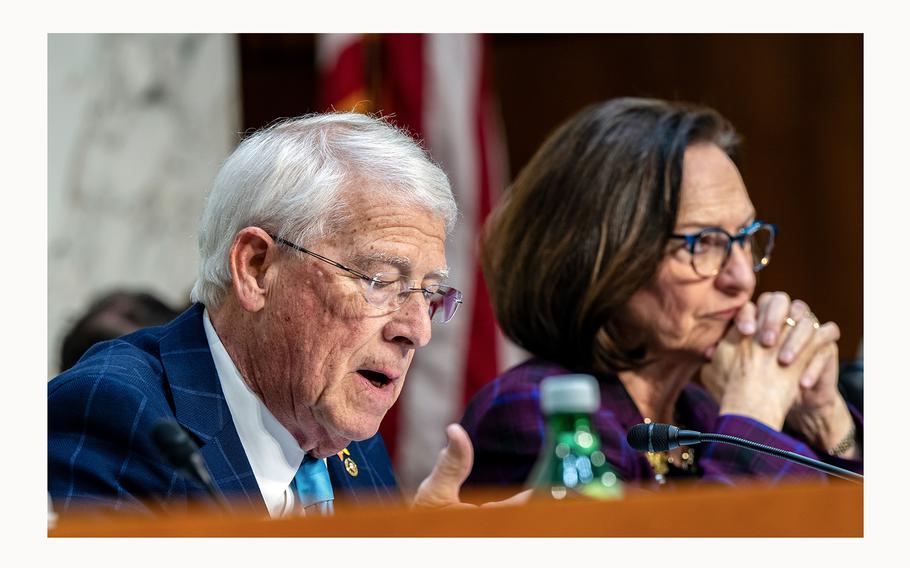
Sens. Roger Wicker, R-Miss., and Deb Fisher, R-Neb., on Feb. 29, 2024, at a Senate Armed Services Committee hearing in the Dirksen Senate Office Building in Washington. (Eugene Oliver/Department of Defense)
WASHINGTON — The top Republican on the Senate Armed Services Committee released a plan on Wednesday calling for a “generational investment” in the military, beginning with a $55 billion increase to the fiscal 2025 defense budget.
Sen. Roger Wicker of Mississippi said the U.S. must aggressively build up its military and boost weapons production to counter immediate threats and prepare for long-term competition with China, Russia, Iran and North Korea.
“Defense investment does not guarantee victory. But failing to invest properly denies us a chance to deter war,” Wicker wrote in a report outlining the investment plan. “Right now we are spending too little.”
The White House is requesting $895 billion in national security spending for the 2025 fiscal year, including $850 billion specifically for the Pentagon. The figures represent a 1% increase from the previous year and are in keeping with funding limits imposed by a debt limit deal last year.
The House Armed Services Committee stuck to the White House’s topline when it approved its version of an annual defense authorization bill last week. But Wicker on Wednesday said he will push for the Senate to go higher.
The Senate Armed Services Committee will begin its deliberations next month over the 2025 National Defense Authorization Act, which establishes recommended funding levels for the Pentagon.
Wicker’s plan calls for military spending to grow to 5% of America’s gross domestic product, or total economic output, in the next five to seven years. The annual defense budget is now at about 3% of GDP and nearing historic lows, according to the report.
By contrast, China is planning a 7.2% spending increase on defense and Russia has mobilized its economy for a prolonged confrontation with the West. Together with Iran and North Korea, the emerging “axis of aggressors” is working to undermine U.S. interests around the world, Wicker said.
“The United States is facing the most dangerous threat environment since World War II, and the country needs a generational investment in its military to protect itself,” the report states.
Wicker’s blueprint to put the U.S. on wartime footing includes a heightened presence in Europe, where Russia is waging war in Ukraine, and in the Indo-Pacific region, where China is flexing its military muscle and eyeing an invasion of Taiwan.
He recommends permanently basing an armored brigade combat team in Poland as well as increasing rotational deployments of U.S. troops in Eastern Europe. The Pentagon established its first permanent garrison in Poland in 2023.
In the Indo-Pacific, Wicker wants the U.S. to consider new nuclear-sharing agreements and the re-deployment of U.S. tactical nuclear weapons in Korea. He also proposes accelerating the military modernization of Taiwan and the Philippines and buying them asymmetrical weapons.
Wicker’s recommendations also target individual services and the defense industrial base. He is pressing for the production of more ships, fighter jets and missiles.
“We struggle to build and maintain ships, our fighter jet fleet is dangerously small, and our military infrastructure is outdated,” Wicker wrote in an op-ed in The New York Times on Wednesday. “Meanwhile, America’s adversaries are growing their militaries and getting more aggressive.”
Under his blueprint, the Navy would grow its fleet to 357 ships by 2035 and the Air Force would buy at least 340 additional aircraft in five years. Wicker’s plan proposes spending $7 billion to $10 billion on the munitions industrial base each year for the next decade to rebuild “a lasting 21st-century arsenal of democracy.”
Wicker is not alone in pressing for more money for the military.
Top lawmakers on the Senate Appropriations Committee have expressed concerns that the proposed budget for 2025 will cause the military to forego critical investments in future technology and shortchange the Pentagon at a time of global turmoil.
“We need a bigger number,” Sen. Jon Tester of Montana, the Democratic chairman of the committee’s defense subpanel, said earlier this month.
Other Democrats are more resistant, demanding any increase in defense spending is matched by funding boosts to domestic programs. Sen. Patty Murray of Washington, the Democratic chairwoman of the Appropriations Committee, said she will “insist on parity for nondefense spending.”